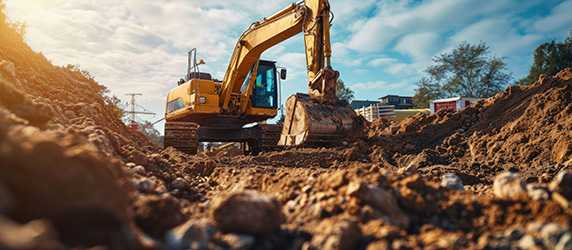Safeguarding workers during trenching and excavation operations

In April of 2023, two construction workers were tasked with moving a utility under a concrete slab at a commercial jobsite in New York. During the excavation process, the slab gave way fatally crushing both workers. This is just one of many tragic instances where if proper safety and planning were in place, lives could have been saved. The Occupational Safety and Health Administration’s (OSHA) post incident investigation determined the company failed to adequately support the slab above the trench, failed to instruct workers on safety methods and failed to utilize excavation protective systems.6
Unprotected trench walls pose several risks. They can collapse without warning, endangering workers. Workers may also be struck by equipment, exposed to significant falls, or at risk from falling loads and hazardous atmospheres. From 2003 to 2017 there were 373 fatalities related to trenching.1 Even with advancements in technology and overall awareness, trenching fatalities have continued to trend upwards in recent years. Annual fatalities have increased from an average of 21 per year from 2011-2018 to 39 in 2022 alone,2 with construction accounting for more than 80% of those statistics.1
What's Behind the Issue
The National Safety Council (NSC) recently conducted a survey to assess the state of the industry. They surveyed individuals performing the work as well as Safety and Health professionals. The survey looked at experience, pre-planning, safeguards being used, competent persons, and the general understanding of federal regulations regarding trenching.3 Key findings included:
- Lack of training on trench safety - 67.0%
- Indifference (i.e., “It won't happen on my watch”) - 58.1%
- Lack of knowledge of the OSHA 1926.650 Trenching and Excavation standard - 52.2%
In short, the results showed that there were deficiencies throughout the industry in training, education, and awareness of the hazards associated with trenching activities.
What You Can Do
Most all trenching and excavation injuries and fatalities are preventable. According to NIOSH, the most effective way to prevent trenching fatalities is to use alternatives to trenching. These trenchless alternatives could include directional drilling/boring, pipe lining, pipe jacking, etc. These methods can greatly reduce the amount of trenching required on a job and thus greatly reduce the exposure to workers.5 If trenchless alternatives are not available, then ownership and management need to make a commitment to act immediately and keep workers safe. Action steps could include:
- Training employees on the hazards of trenching and excavation
- Designating a competent person
- Implementing protective systems for all trenches 5 or more feet deep
- Never allowing an employee to enter an unprotected trench
- Following basic requirements set forth in 1926 Subpart P
- Conducting refresher training through toolbox talks
- Participating in the Trench Safety Stand Down Week
Training and Education
The cornerstone of every good safety program is employee training. The employer must instruct each employee in the recognition of hazards for the job and avoidance of unsafe conditions. These hazards could include:
- Soil types and potential cave-in hazards
- Equipment hazards
- Hazards posed by materials placed at the edge of the trench
- Standing water hazards
- Hazardous atmospheres
- Fall hazards
- Entry and exit hazards
- Hazards from adjacent roadways, sidewalks, or structures
All training should be conducted in a format and language that the workers can understand and documented in the employee’s personnel file.
Training employees regarding potential hazards is the first step. Employees should also be familiar with, and employers must follow requirements outlined in OSHA’s 1926 Subpart P - Excavations.4 This standard covers precautions needed for safe excavation work including:
- Preplanning requirements
- Locating utilities
- Assessing site hazards
- Assigning a competent person
- Creating an emergency action plan for the site.
- Soil identification
- Trenching techniques (benching and sloping)
- Safeguards (shoring, trench boxes)
- Safe egress
- Water accumulation
- Requirements for hazardous atmospheres
- Inspections
- Supervision
Nationwide recognizes the hazardous nature of trenching and excavation and also realizes that one fatality is too many. Because of this we have developed a resource that offers an overview of industry best practices for trenching and excavation.
1 National Institute for Occupational Safety and Health (NIOSH). Trenching and Excavation Safety. February 23, 2024.
2 U.S. Department of Labor. State Agencies, Industry Leaders Launch Campaign to Educate Workers of Deadly Excavation Hazards. April 10th, 2023.
3 National Safety Council. Trench and Excavation Hazards: Insight on Newly Acquired Data and Managing the Risks. September 6, 2019.
4 Occupational Safety and Health Administration. https://www.osha.gov/laws-regs/regulations/standardnumber/1926/1926SubpartPAppA.
5 Centers for Disease Control and Prevention. Preventing Trench Fatalities. June 6, 2019.
6 Occupational Safety and Health Administration. OSHA News Release - Region 2. October 16, 2023.
